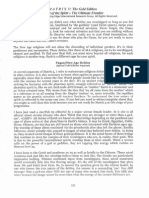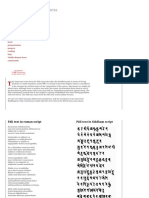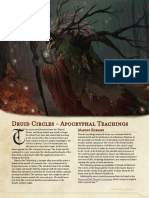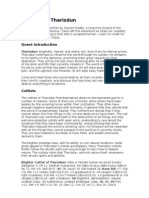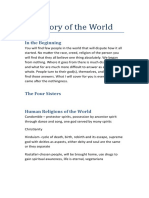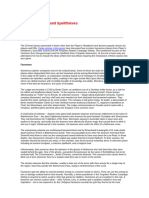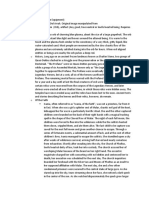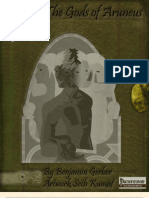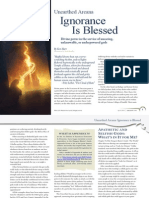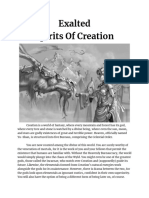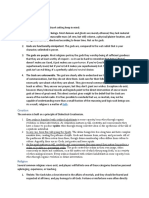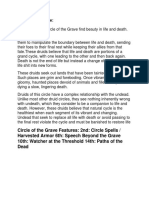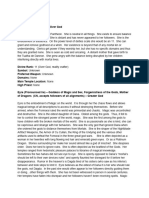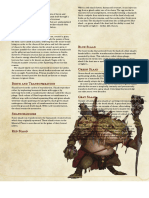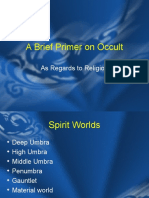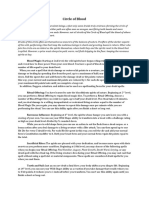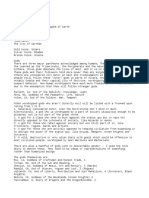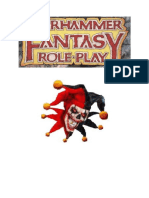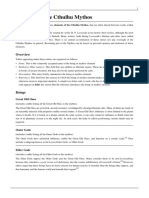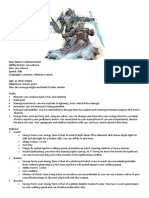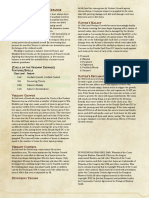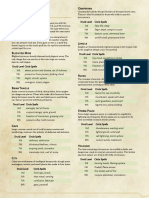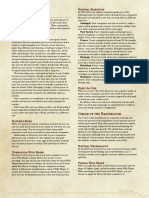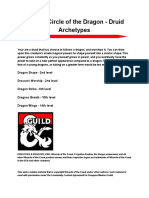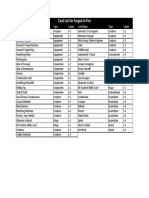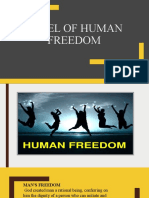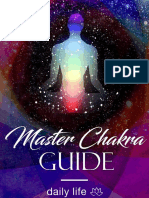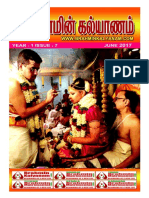Circle of The Moon
Circle of The Moon
Uploaded by
jerryb1966Copyright:
Available Formats
Circle of The Moon
Circle of The Moon
Uploaded by
jerryb1966Original Description:
Original Title
Copyright
Available Formats
Share this document
Did you find this document useful?
Is this content inappropriate?
Copyright:
Available Formats
Circle of The Moon
Circle of The Moon
Uploaded by
jerryb1966Copyright:
Available Formats
Circle of the Moon(PHB)
Druids of the Circle of the Moon are fierce guardians of the wilds. Their order gathers under the full
moon to share news and trade warnings. They haunt the deepest parts of the wilderness, where they
might go for weeks on end be fore crossing paths with another humanoid creature, let a lone another
druid. Changeable as the moon, a druid of this circle might prowl as a great cat one night, soar over the
treetops as an eagle the next day, and crash through the undergrowth in bear form to drive off a
trespassing monster. The wild is in the druid's blood.
Combat Wild Shape
When you choose this circle at 2nd level, you gain the ability to use Wild Shape on your turn as a bonus
action, rather than as an action. Additionally, while you are transform ed by Wild Shape, you can use a
bonus action to expend one spell slot to regain 1d8 hit points per level of the spell slot expended.
Circle Forms
The rites of your circle grant you the ability to transform into more dangerous animal forms. Starting at
2nd level, you can use your Wild Shape to transform into a beast with a challenge rating as high as 1
(you ignore the Max. CR column of the Beast Shapes table, but must abide by the other limitations
there). Starting at 6th level, you can transform into a beast with a challenge rating as high as your druid
level divided by 3, rounded down
Primal Strike
Starting at 6th level, your attacks in beast form count as magical for the purpose of overcoming
resistance and immunity to nonmagical attacks and damage.
Elemental Wild Shape
At 10th level, you can expend two uses of Wild Shape at the same time to transform into an air
elemental, an earth elemental, a fire elemental, or a water elemental.
Thousand Forms
By 14th level, you have learned to use magic to alter your physical form in more subtle ways. You can
cast the alter self spell at will.
Druids and the Gods
Some druids venerate the forces of nature themselves, but
most druids are devoted to one of the many nature deities
worshiped in the multiverse (the lists of gods in appendix
B include many such deities). The worship of these deities
is often considered a more ancient tradition than the faiths
of clerics and urbanized peoples. In fact, in the world of
Greyhawk, the druidic faith is called the Old Faith, and it
claims many adherents among farmers, foresters, fishers,
and others who live closely with nature. This tradition
includes the worship of Nature as a primal force beyond
personification, but also encompasses the worship of Beory,
the Oerth Mother, as well as devotees of Obad-Hai, Ehlonna,
and Ulaa. In the worlds of Greyhawk and the Forgotten Realms, druidic
circles are not usually connected to the faith
of a single nature deity. Any given circle in the Forgotten Realms,
for example, might include druids who revere Silvanus,
Mielikki, Eldath, Chauntea, or even the harsh Gods of Fury:
Talos, Malar, Auril, and Umberlee. These nature gods are
often called the First Circle, the first among the druids, and
most druids count them all (even the violent ones) as worthy
of veneration. The druids of Eberron hold animistic beliefs completely
unconnected to the Sovereign Host, the Dark Six, or any of the other
religions of the world. They believe that every living thing and every
natural phenomenon— sun, moon, wind, fire, and the world itself—has
a spirit. Their spells, then, are a means to communicate with and
command these spirits.
Different druidic sects, though, hold different philosophies
about the proper relationship of these spirits to each other
and to the forces of civilization. The Ashbound, for example,
believe that arcane magic is an abomination against nature,
the Children of Winter venerate the forces of death, and the
Gatekeepers preserve ancient traditions meant to protect the
world from the incursion of aberrations.
You might also like
- MATRIX V - Quest of The Spirit 3Document122 pagesMATRIX V - Quest of The Spirit 3CoRo2013100% (5)
- The Vecna DossierDocument3 pagesThe Vecna Dossierjerryb1966No ratings yet
- Dark Druids The Circle of Apostasy: Because Druids Can Be Evil TooDocument4 pagesDark Druids The Circle of Apostasy: Because Druids Can Be Evil Toojerryb1966No ratings yet
- Holy Orders of The StarsDocument4 pagesHoly Orders of The StarsLuis Carlos Suarez CaballeroNo ratings yet
- Creating Muslim Space in The USADocument20 pagesCreating Muslim Space in The USAm husaynNo ratings yet
- Karaniya Metta Sutta in The Siddham ScriptDocument4 pagesKaraniya Metta Sutta in The Siddham ScriptAtanu Datta100% (1)
- Druid Circles - Apocryphal TeachingsDocument4 pagesDruid Circles - Apocryphal TeachingsAdam WaltonNo ratings yet
- PF - FAE - Class - The DruidDocument14 pagesPF - FAE - Class - The DruidMatthew FennNo ratings yet
- The Cult of TharizdunDocument23 pagesThe Cult of TharizdunDanielAM79100% (1)
- Gods of Mikkleheimr (Lore For 5e Homebrew World)Document8 pagesGods of Mikkleheimr (Lore For 5e Homebrew World)Jake ShepherdNo ratings yet
- Merth Intro Doc Minus ProudfootDocument7 pagesMerth Intro Doc Minus ProudfootMenkoyNo ratings yet
- TharizdunDocument9 pagesTharizdunagentgex13No ratings yet
- The Story of The WorldDocument7 pagesThe Story of The WorldPhilmore PocketsNo ratings yet
- Druid CirclesDocument14 pagesDruid CirclesAdalberto Cristh50% (2)
- Factotums and SpellthievesDocument3 pagesFactotums and SpellthievesiosonosogekingNo ratings yet
- Circle of The Ancestors: A Druid Circle For 5 EditionDocument2 pagesCircle of The Ancestors: A Druid Circle For 5 EditionJerry BryantNo ratings yet
- Ixi SpecsDocument8 pagesIxi Specswawavol722No ratings yet
- ArtifactsDocument8 pagesArtifactsTim TimmersonNo ratings yet
- Druids: Presentation by Anton Linok & Gleb MackevichDocument7 pagesDruids: Presentation by Anton Linok & Gleb MackevichFcorkSunJouce 34No ratings yet
- Gods of AruneusDocument13 pagesGods of Aruneusapulcino42100% (1)
- 398 Strange GodsDocument10 pages398 Strange GodsNaoth100% (1)
- Middle Finger of Vecna Class Pack 2Document15 pagesMiddle Finger of Vecna Class Pack 2Anonymous 05VM7O27o89% (9)
- Circle of The BoundaryDocument2 pagesCircle of The BoundaryISAI dali Perez navaNo ratings yet
- Piety Details For GuldorDocument3 pagesPiety Details For GuldorJacob SutherlandNo ratings yet
- Exalted - Spirits of CreationDocument102 pagesExalted - Spirits of CreationXsaNo ratings yet
- Stormlight Archive JumpDocument17 pagesStormlight Archive JumpDorothy FeelyNo ratings yet
- Guide Grayhawk City Systemless PDFDocument39 pagesGuide Grayhawk City Systemless PDFSophia FletcherNo ratings yet
- Gods of The NecronomiconDocument1 pageGods of The Necronomiconxdarby100% (2)
- Seans HomebrewDocument3 pagesSeans HomebrewAnonymous k7vd62SNo ratings yet
- Table: The Druid: Level Special 0 1 2 3 4 5 6 7 8 9Document7 pagesTable: The Druid: Level Special 0 1 2 3 4 5 6 7 8 9Andrew SchroepferNo ratings yet
- DeitiesDocument11 pagesDeitiesDracus SteamworkNo ratings yet
- Half-Giant Player Character RaceDocument8 pagesHalf-Giant Player Character RaceMimsyNo ratings yet
- 25 PurvabhadrapadaDocument8 pages25 PurvabhadrapadaSteve Hancock100% (1)
- The Tuatha de DannonDocument7 pagesThe Tuatha de DannonSomethingRandom200No ratings yet
- Chapter Eight Guides, Guardians and Gods: Our TeachersDocument10 pagesChapter Eight Guides, Guardians and Gods: Our TeachersKrestaNo ratings yet
- 101 6th Level Spells (Screen) PDFDocument33 pages101 6th Level Spells (Screen) PDFJohn Frangos75% (4)
- Kamigakari Requiem of A Divinity Manuscript 01 - 2024 Part 1Document7 pagesKamigakari Requiem of A Divinity Manuscript 01 - 2024 Part 1Dave SaserNo ratings yet
- DL Gods - Matter of TheologyDocument29 pagesDL Gods - Matter of TheologyryuukaiNo ratings yet
- Gods of AruneusDocument13 pagesGods of AruneusKyle SuttonNo ratings yet
- The Hexing Scrolls Printer Friendly PDFDocument3 pagesThe Hexing Scrolls Printer Friendly PDFyatib23527No ratings yet
- Half DragonDocument5 pagesHalf DragonBatata Frita100% (1)
- Shattered Star RerunDocument4 pagesShattered Star RerunNifty SunSetNo ratings yet
- Dd3 - We - Called To ServeDocument3 pagesDd3 - We - Called To ServeJames YuNo ratings yet
- Druid Circles - GM BinderDocument11 pagesDruid Circles - GM BinderAbner TapiaNo ratings yet
- Slaadi - Player Race 5e - The HomebreweryDocument3 pagesSlaadi - Player Race 5e - The HomebreweryeduardfarzaliievNo ratings yet
- A Brief Primer On Occult: As Regards To ReligionDocument34 pagesA Brief Primer On Occult: As Regards To ReligionabstockingNo ratings yet
- Great Mother (Dungeons & Dragons)Document3 pagesGreat Mother (Dungeons & Dragons)descataNo ratings yet
- Druid Subclass - Circle of BloodDocument2 pagesDruid Subclass - Circle of BloodAz ComicsNo ratings yet
- Demi-Dragon - InglésDocument57 pagesDemi-Dragon - InglésariakasNo ratings yet
- (HIGHLY CLASSIFIED) TosmologyDocument49 pages(HIGHLY CLASSIFIED) TosmologyJohn Lloyd MempinNo ratings yet
- Forsaken Scales: Dragonborn TraitsDocument2 pagesForsaken Scales: Dragonborn Traits66 6100% (1)
- D&D World BuilderDocument2 pagesD&D World BuilderMeghan Kathleen Van DyneNo ratings yet
- Druids of The Old FaithDocument5 pagesDruids of The Old Faithmonel_24671No ratings yet
- Circle of The ScaleDocument1 pageCircle of The ScaleI love you Evans PeterNo ratings yet
- Vlaroa World BuilderDocument9 pagesVlaroa World BuilderBeau StapleyNo ratings yet
- Savage Worlds - Warhammer Fantasy RoleplayDocument10 pagesSavage Worlds - Warhammer Fantasy RoleplayBrandon HarrisNo ratings yet
- Circle of The BeastDocument1 pageCircle of The BeastVictor Wanderley CorrêaNo ratings yet
- 1421993955673Document14 pages1421993955673will smith100% (1)
- Eladrin (Celestial)Document3 pagesEladrin (Celestial)deadtree34No ratings yet
- Expanded Greater UndeadDocument43 pagesExpanded Greater UndeadKristopher Garrett100% (6)
- Lord Heimharts Magical Items - Volume 5 - Oddities & UnusualDocument5 pagesLord Heimharts Magical Items - Volume 5 - Oddities & Unusualjerryb1966No ratings yet
- DMsGuild-Wolfs Tome of Minor ArtifactsDocument6 pagesDMsGuild-Wolfs Tome of Minor Artifactsjerryb1966No ratings yet
- Circle of The Verdant ExpanseDocument1 pageCircle of The Verdant Expansejerryb1966No ratings yet
- Druid Circles: Circle of The BeastDocument4 pagesDruid Circles: Circle of The Beastjerryb1966No ratings yet
- Druid Circles: Circle of The LandDocument2 pagesDruid Circles: Circle of The Landjerryb1966No ratings yet
- Druid Circles: Circle of The PlanesDocument2 pagesDruid Circles: Circle of The Planesjerryb1966No ratings yet
- Druid Circles: Circle of The BeastDocument4 pagesDruid Circles: Circle of The Beastjerryb1966No ratings yet
- D&D 5E Circle of The Dragon Druid ArchetypesDocument5 pagesD&D 5E Circle of The Dragon Druid Archetypesjerryb1966No ratings yet
- Cleric: Punishment Domain: Channel Divinity: Iron MaidenDocument1 pageCleric: Punishment Domain: Channel Divinity: Iron Maidenjerryb1966No ratings yet
- Cleric Subclass - Shadow DomainDocument1 pageCleric Subclass - Shadow Domainjerryb1966No ratings yet
- Madness Domain: Domain Spells Potent SpellcastingDocument1 pageMadness Domain: Domain Spells Potent Spellcastingjerryb1966No ratings yet
- Cleric-Drunken DomainDocument4 pagesCleric-Drunken Domainjerryb1966No ratings yet
- Fear Domain: Domain Spells Divine StrikeDocument1 pageFear Domain: Domain Spells Divine Strikejerryb1966No ratings yet
- Path of The Warden: Primal InfusionDocument2 pagesPath of The Warden: Primal Infusionjerryb1966No ratings yet
- Bard: College of The Death DancerDocument1 pageBard: College of The Death Dancerjerryb1966No ratings yet
- Barbarian Primal Path of The VikingDocument1 pageBarbarian Primal Path of The Vikingjerryb1966No ratings yet
- God Slayer: Fury of The MortalDocument1 pageGod Slayer: Fury of The Mortaljerryb1966No ratings yet
- College of Nature: Druidic LoreDocument1 pageCollege of Nature: Druidic Lorejerryb1966No ratings yet
- Battle DancerDocument3 pagesBattle Dancerjerryb1966No ratings yet
- Experience Ix IDocument22 pagesExperience Ix IGior Hard BojesNo ratings yet
- Becoming OneDocument2 pagesBecoming OnecontatoNo ratings yet
- Sant Mat PDFDocument4 pagesSant Mat PDFDeroy GarryNo ratings yet
- Mayadevi Temple Recent Discoveries and Its Implications On History of Building at LumbiniDocument14 pagesMayadevi Temple Recent Discoveries and Its Implications On History of Building at LumbiniSujan ShresthaNo ratings yet
- Hindu Calendar 2020 PDFDocument25 pagesHindu Calendar 2020 PDFRCHOURASIYANo ratings yet
- Hadith Al Jaami3Document127 pagesHadith Al Jaami3Vi DoNo ratings yet
- Jews Fighting The News - Zman Magazine 78Document10 pagesJews Fighting The News - Zman Magazine 78Eldad TzioniNo ratings yet
- Analysis of The Customs of The Tagalogs (Readings in Phil. History)Document2 pagesAnalysis of The Customs of The Tagalogs (Readings in Phil. History)JeahannNo ratings yet
- Cornel West and John Frame On Paul Holmer - WunderlistDocument1 pageCornel West and John Frame On Paul Holmer - WunderlistpublicbiographyNo ratings yet
- Clanbook Brujah PDFDocument100 pagesClanbook Brujah PDFMario Carvalho100% (4)
- Pak - Studies SolutionDocument3 pagesPak - Studies SolutionJohn RazaNo ratings yet
- Card List For Forged in Fire: Card Name Type Copies Card Name Type CopiesDocument1 pageCard List For Forged in Fire: Card Name Type Copies Card Name Type CopiesAnonymous NFGneM7DNNo ratings yet
- Glory Be To God The FatherDocument1 pageGlory Be To God The FatherLei Z.No ratings yet
- Level of Human FreedomDocument8 pagesLevel of Human FreedomJohnrommel ErcillaNo ratings yet
- Tahun 4 2018 - Guru Kelas - 5Document40 pagesTahun 4 2018 - Guru Kelas - 5afham255No ratings yet
- Story of Joseph As History of The SoulDocument8 pagesStory of Joseph As History of The SoulHasanNo ratings yet
- Trigger, Bruce. (2008). “Early cities: craft workers, kings and controlling the supernatural” (pp 58 - 66). In: Joyce Marcus and Jeremy Sabloff (eds), The Ancient City: new perspectives on urbanism in the old and new world. New Mexico: A School for Advanced Research.Document10 pagesTrigger, Bruce. (2008). “Early cities: craft workers, kings and controlling the supernatural” (pp 58 - 66). In: Joyce Marcus and Jeremy Sabloff (eds), The Ancient City: new perspectives on urbanism in the old and new world. New Mexico: A School for Advanced Research.Adrian TorresNo ratings yet
- Tahaniel - Bowed Down of GodDocument10 pagesTahaniel - Bowed Down of GodMarkosNo ratings yet
- The Face Of: Holy Our LordDocument91 pagesThe Face Of: Holy Our Lordsalveregina1917No ratings yet
- On Salvation Outside Orthodoxy: Thoughts On The Article "Ecumenoclasm: Who Can Be Saved?"Document3 pagesOn Salvation Outside Orthodoxy: Thoughts On The Article "Ecumenoclasm: Who Can Be Saved?"HibernoSlavNo ratings yet
- EnglandDocument6 pagesEnglandEvelin KosarasNo ratings yet
- Bubalo, Joining The Caravan 1Document149 pagesBubalo, Joining The Caravan 1Aufannuha IhsaniNo ratings yet
- Master Chakra GuideDocument44 pagesMaster Chakra GuideMarcos Pagani100% (2)
- 13 DBQ 4 All of Unit 4 Google DocsDocument5 pages13 DBQ 4 All of Unit 4 Google Docschenjy38No ratings yet
- Brahmin Kalyanam: JULY 2016Document48 pagesBrahmin Kalyanam: JULY 2016bharadwajNo ratings yet
- The FuriesDocument3 pagesThe FuriesJuan diego Delgado gomezNo ratings yet
- To His Coy Mistress Is A Dramatic Monologue, Structured As A 46-Line Single StanzaDocument3 pagesTo His Coy Mistress Is A Dramatic Monologue, Structured As A 46-Line Single StanzaElizabeth HernándezNo ratings yet
- To The Women of MalolosDocument14 pagesTo The Women of MalolosBlessie NgitngitNo ratings yet
